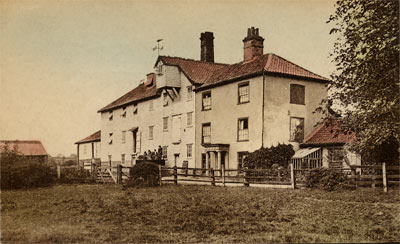 |
|
Mendham Mill and house c.1910
|
|
Mendham Mill
River Waveney |
 |
|
Mendham Mill and house c.1910
|
|
Mendham Mill
was rebuilt and greatly enlarged in 1820 of weatherboard with a pantiled roof. The adjoining
mill house did not appear to line up with the mill's window configuration,
which was quite unusual and almost certainly because the house was older than the rebuilt mill - the house was described as new-built in 1813. |
|
The abbot and convent of Sibton, in Suffolk, had a fifhery, and water-mill, called Fryer's-mill, in this place, (Mendham) which was lett with their grainge and manor of Weybrede, in Suffolk, which in 1611 belonged to George Herring of Norwich. History and antiquities of the county of Norfolk |
|
The earlier mill had run two pairs of French burr stones and ground up to 5 lasts of corn per week. |
|
Stephen Spratt ceased to run the mill in 1807 but it is not known if he died or became insolvent. |
|
When advertised for sale in 1808, the mill was using French burr stones to grind wheat for flour. |
 |
|
Ipswich Journal - 9th January 1808 |
 |
|
Mill dam c.1904
|
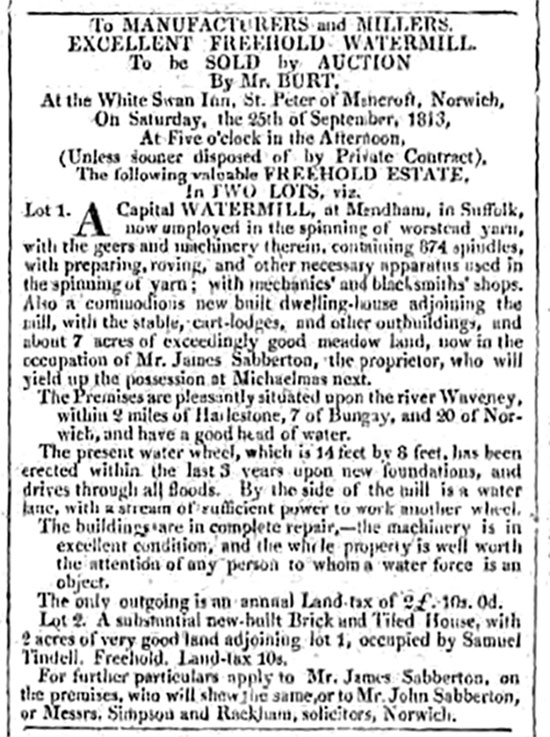 |
|
Ipswich Journal - 11th September 1813 |
 |
|
Ipswich Journal - 1st January 1814 |
|
A new iron
waterwheel was installed in 1861 having been cast at Harleston Foundry and replaced the 1820 one that at one time had driven 9 pairs of stones. |
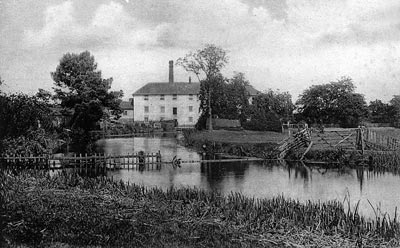 |
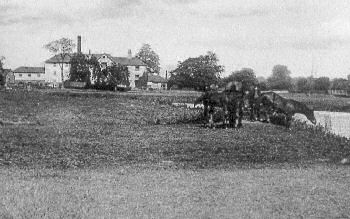 |
c.1914 |
c.1915 |
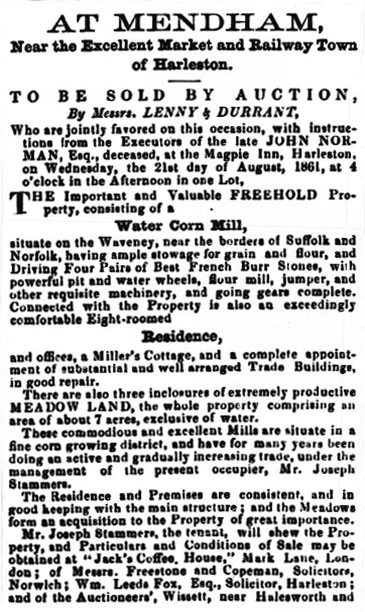 |
Suffolk Chronicle - 17th August 1861 |
| John Stammers, born 1822, second son of Robert Stammers of Magdalen_Gates_post_mill, Pockthorpe, Norwich. At Wymondham 1850 - 1858. Went to Dilham watermill by 1861 and to Mendham watermill 1864. Letter from David Cubitt, Norwich, to Harry Apling - December 1982 N.B. John's brother Joseph Stammers, was miller at Mendham |
Joseph Stammers was the tenant miller in 1861, he was also a farmer owning 260 acres and employing 10 men. His daughter Rosa married Thomas Pratt, a well known Harleston Solicitor and they lived at The Beeches in London Road. In 1881 Rosa's mother, Harriett, then a widow lived with her son in law and daughter. |
 |
|
Suffolk Chronicle - 25th March 1865 |
c.1871 a grasshopper beam engine, manufactured and installed by Holmes & Sons of Norwich was in constant use. The engine ran continuously for 50 years, mostly day and night and was operated exclusively by James Souter and no one else was allowed to interfere. When the engine was dismantled in 1851, the old man died of a broken heart, it had been his life. |
|
My grandfather came here into partnership with George Chase in 1872, having served his apprenticeship with his cousin James Stannard at Nayland in 1854, and was there for 18 years. Chase and Munnings also had Weybread_Mill. Chase was killed in 1887, when he was thrown out of his dog-cart in Harleston. My grandfather kept Mendham Mill on and fitted a partial roller plant, keeping 4 of the 8 pairs of millstones for under-runners, and a complete Turner 3 sack roller plant in 1905. Flour was carted to Bungay staithe, wher it was taken to Yarmouth by wherry, and shipped from there to London and Newcastle. My late famous uncle Sir Alfred Munnings K.V.C.O. P.P.R.A. was born here in 1878, to join Constable and Rembrandt as famous millers sons who became great artists. My father carried on the mill, flour milling ceased in 1932, and provender milling was carried on until 1938 when the mill was turned into a private residence. John Munnings |
 |
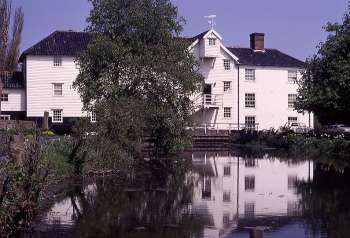 |
The mill dam c.1910 |
May 1972 |
|
The artist Alfred Munnings, son of the miller was born in the Mill House in 1878 and was brought up in the village. |
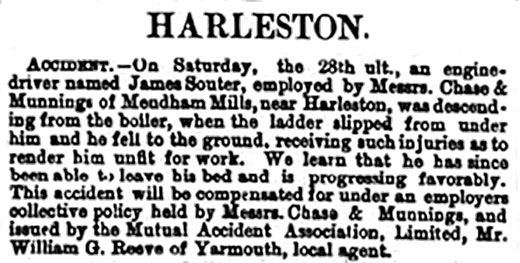 |
|
Norfolk News - 11th November 1882 |
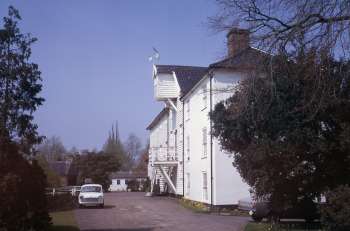 |
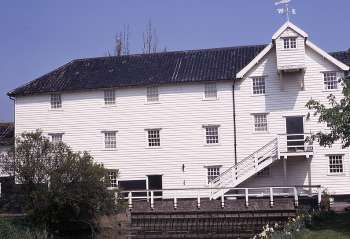 |
|
Mill and house May 1972
|
May
1972 |
|
On 22nd November 2002 the Eastern Daily Press reported that the mill was on the market for £1.2 million. |
|
Race far away from the daily grind |
|
Equestrian and war artist Sir Alfred Munnings was born at Mendham Watermill, Norfolk, in 1878 and drew inspiration from the setting for many of his early paintings. The present building, surrounded by the water meadows of the Waveney valley, dates from 1807, although a mill is recorded on this site in the Domesday Book. The mill is split into four parts. The casually elegant main home is over the top two floors in the centre of the building, with fabulous views. The first floor includes a sitting room, large drawing room and dining room, all with panelled walls and elm flooring. Upstairs there are four bedrooms and two bathrooms, one en suite. Munnings' family lived in the Miller's House on the eastern end of the mill, which is now run as one of four possible holiday lets attached to the property. This has four bedrooms, a sitting room and two shower rooms. The Mill Race Cottage, with two bedrooms, is at the other end of the building, and the one-bedroom Miller's Nest is on the ground floor of the main mill. A holiday let - the detached Miller's Lodge - has french doors opening from the sitting room on to a terrace and walled garden. Anyone who fancies embellishing the Munnings theme by reintroducing horses could fence off some of the seven acres that come with the property to form paddocks. In 1938 the mill sold for £1,600. Agents Jackson-Stops &
Staff (01473 218218) is now asking for £1.2 million. |
I lived in Mendham Mill in 1953 when I was six years old. My Mother worked as a cook for Brigadier Scott and Mrs Scott who owned the Mill (I presumed) and farmed in the area. We had moved from London after my Mother’s previous employer, a doctor, was one of the 4000 people who had died in the 1952 December smog. Obviously, moving from Knightsbridge (alright Brompton!) literally just round the corner from Harrods, to Mendham with one shop was a bit of a change, but for a young boy playing games undetected alongside the river Waveney was preferable to the Serpentine, where even in those days, some busybody was telling you to go and play somewhere else. I must admit that 51 years later I remember the dogs of the mill better than the people who worked or lived there. The Brigadier had a black labrador gun dog called Sailor, the was spaniel called Prue. Mrs Scott had a nasty black poodle - Lady and my favourite was Jess a greyhound. David Halliwell or I would hold her back while the other would run up the lane from the mill to the house by the stream where he lived and then gasp as she shot off when set free. There were two families on the farm; the Halliwell’s and the Seamen’s. David, Jennifer Seamen and I were in the same class at school. If you want a picture of them and the others in our class of nine!–go to Friends Reunited - Mendham School and look at the photograph. The farm was a mixed farm with cattle, pigs, and poultry and, at Christmas, geese. I collected eggs from the battery houses to the right and opposite the mill; I helped feed the dozens of cats who lived under the sheds. The area under the mill was where the poultry and the geese were killed and had their feathers stripped. It was busy at Christmas with extra ladies from the village taken on to help. There was a large electrically powered watermill that could on the press of a button be sent into reverse. This created a counter flow to the water flowing through the mill (as you know the main current goes past the boathouse and round the mill) and drove the accumulated debris that blocked the grating under the road back upstream. The debris was then pulled onto the bank. This did two things, it stopped a build up of water level in front of the mill and reduced the risk of bits of wood and flotsam getting into the waterworks - so to speak. I was passing Mendham, coming back from holiday with my family a few years ago and dropped by. Luckily the new owners were there and invited me in to have a look around. The watermill that shook the place when running was rusted away, and the stone steps that ran up to the kitchen from the walled garden had gone. The chicken houses were I think a holiday home! I wonder if the residents know! It was obviously in need of renovation, but although it seemed smaller than when I was a lad I wasn’t sorry I had gone back, so often fond memories are trick of the mind and you are disappointed… but no so with Mendham Mill I had no idea then that Alfred Munnings had been born there and I do not recall it ever being mentioned. My Mother had Saturdays off and we would go into Harleston to the pictures. I was in Harleston with a friend from my office (who had holidays there with his Grandparents) en route to a meeting a few years ago. We stopped for a quick look around and called in at the ‘museum’ I asked where the cinema was-or used to be. Can you believe neither of the two worthies there knew!? Perhaps it just dates me. I said we moved to Mendham following the death of my Mother’s previous employer. Unfortunately, we had to move again when Brigadier Scott developed cancer and died. I have real affection for Mendham Mill. |
Charlotte, my wife, remembered her step-father telling her that Grace Philcox, from whom he bought the mill, had run off with her chauffeur. Apparently he paid £14,000 for it and, given the amount of money that she spent refurbishing it, was a bargain. Charlotte thinks that he sold it for £18,000, four years later. My wife’s mother was Jane Carr, star of stage, screen and radio. Robert Stent, who she married in 1955, was MD of Trust House Hotels. Shortly before the wedding Jane was diagnosed with a terminal illness and Robert bought the mill as a weekend and holiday home. My wife loved spending time there and she and her best friend, Nina Campbell, now the celebrity interior designer, painted the punt red and white. I noticed in Sir Alfred Munnings’ book, that he writes about the one that he and his brother used. Many of Jane’s show-biz friends spent time there, although we can only find one picture of Michael Denison and Dulci Grey. Jane had sponsored their application to study at the Central School of Language and Drama, and they in turn, ten years later did the same for Charlotte. As I also mentioned, Jane died in London in 1957, but had insisted on being buried at Mendham. For some reason, best known to himself, Robert Stent had the grave identified by a marker, rather than a gravestone. Maybe, as Charlotte thinks, that was why he was so wealthy. Apparently there was a large eel, affectionately called Ernie, that lived below the wheel and was fed on soft shelled eggs, through a trap door. Charlotte was also able to carry on the Munnings’ tradition by having her own horse. It was named Marcus and had been retired from service with the army, in London. We still have one of his hooves, mounted in silver and used as a doorstep. Derek Southon - 6th March 2007 |
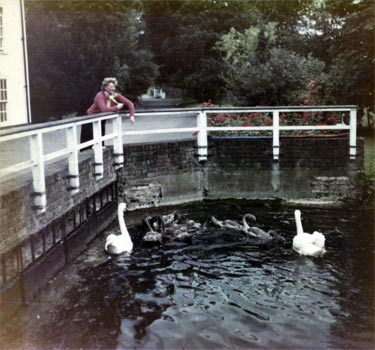 |
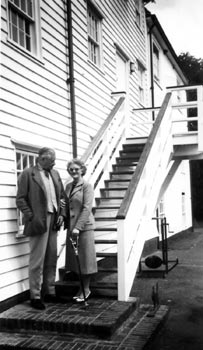 |
Actress Jane Carr c.1955 |
Robert Stent & Jane Carr c.1955 |
Jane Carr died in September 1957 after a two year illness. |
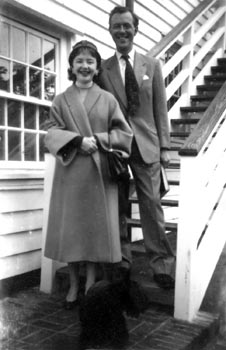 |
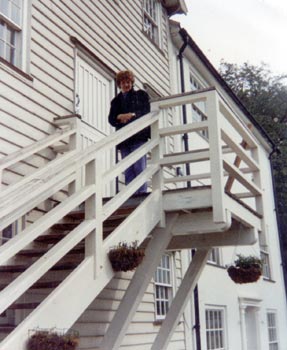 |
Dulcie Gray & Michael Dennison 1955 |
Charlotte Southon 1990 |
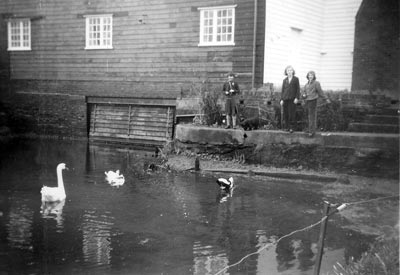 |
Rear of mill 1956 |
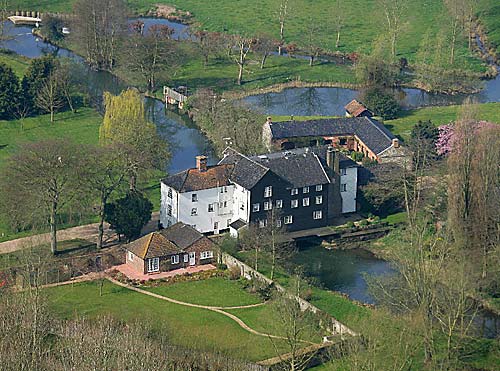 |
5th April 2007 |
|
Robert Stammers (1818-1885) born Norwich and died at Gressenhall as a miller, seems to have occupied the mill from sometime after 1845 - previous tenant or owner John Hannent. Third son Herbert Chapman Stammers (1859-1928) took over the mill and at some date built a large steam mill near Dereham railway station which was later run by John Chapman Stammers (1897-1947). Robert Stammers' younger brother William (1820-1869) became a grocer and draper at Hempnall from whom I have descended. There were two other brothers John (1832 -?) and Joseph (1823-1862) both became millers. John probably at Wymondham,_Browick_Road_mill and Joseph at Mendham. |
|
Apparently there used to be a paper mill in the village on the left side of the bridge near the church but no trace has so far been found. |
|
My father John Moody was born at the mill cottage in 1919 - I believe my great grandfather whose name was Sillette was the miller at the time he had two daughter s Henrietta Ernestina and Ada - Henrietta married Sam Moody who was a printer in Mexborough Yorkshire and Ada married Albert Adams who was a printer in London . |
|
Years ago when a Navigating Officer with Trinity House Harwich I was tinkering with my 1930 Morris Oxford car when a lady approached me, carrying a stuffed black pekinese dog. She called out to a gentleman and said "Alfred I am giving your car away." She said I should call this car "Black night." On towing this 1920 Buick away I understand it was their honeymoon car and cost one thousand pounds at that time. It was yellow and black. I spent some time renovating it and drove it around. I dont have it any more and the last I heard it was parked in London, England. Also have the book "Black Night" written by the dog. |
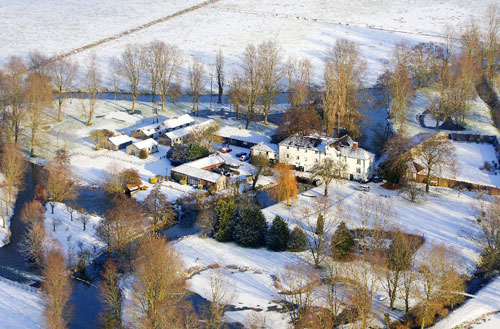 |
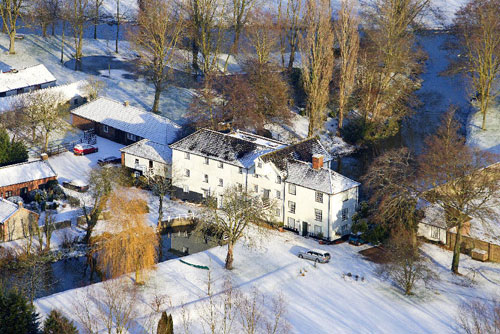 |
3rd January 2010 |
3rd January 2010 showing the channel cut from the main river |
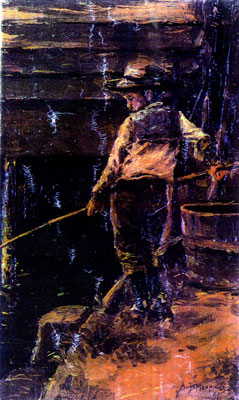 |
Will Saxby of Mendham painted and signed by A. J. Munnings 1896 |
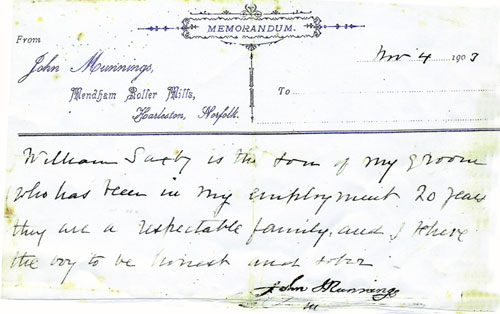 |
Memo written by John Munnings 4th March 1903 |
The script reads: William Saxby is the son of my groom who has been in my employment 20 years they are a respectable family, and I believe the boy to be honest and sober. John Munnings (father of Sir John Munnings) |
My Saxby family all lived in or around Mendham in the 18th century until the
upset in the agriculture mechanisation when they moved to seek other employment.
My grand father went to Bethnal Green in London and eventually became a brewer
at Trumans where he remained for forty years. |
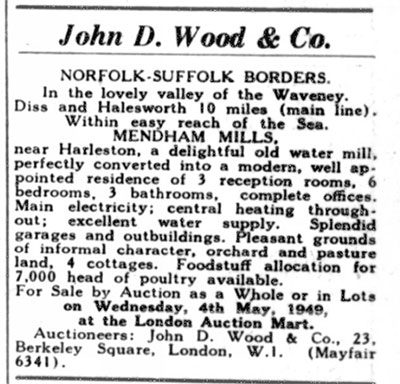 |
Diss Express - 29th April 1949 |
My parents (Tim and Veronica Ellis) bought the Mill, 4 cottages and about 20
acres from the Stents in 1961. At that time there were about 8 old large white sows on the farm and a couple of empty battery houses. With the help of Fred Seaman the herd was built up to c. 120 sows and the battery houses had about 5,000 laying chickens. My parents also acquired a further 10 acres or so and we grew “cricket bat” willows along the river banks. |
I believe this mill was my first home. My parents lived at a watermill in 1951/52 (rented, short term, whilst their house was being built in Yarmouth) I was born in November 1951, at Candler’s Nursing Home in Harleston and that is what is on my birth certificate. My birth registration just says ‘Depwade’, but I don’t think that there was another watermill at that time in the Depwade Hundred. My father was acting Major in the Royal East Anglian Regiment. My mother had been a Wren, based at Bletchley Park for 2 years during the war. They had an enormous Golden Retriever called Sandy and my brother Mike, before I was born. My mother mention 2 idyllic summers at ‘the mill’. |
In that summer before I was born, my mother used to go for walks with the dog and my brother, then a toddler, to a railway. The train drivers of the steam trains saw him waving to them most days and would obligingly blow the whistle for him. Many lines were taken up following Dr Beeching’s cuts to public expenditure, so it may be gone now. |
Another little one my mother told me: my father had Sandy, the oversized Golden Retriever before he met my mum. Sandy was very much was a one man dog, although he was protective towards my mum and my brother. |
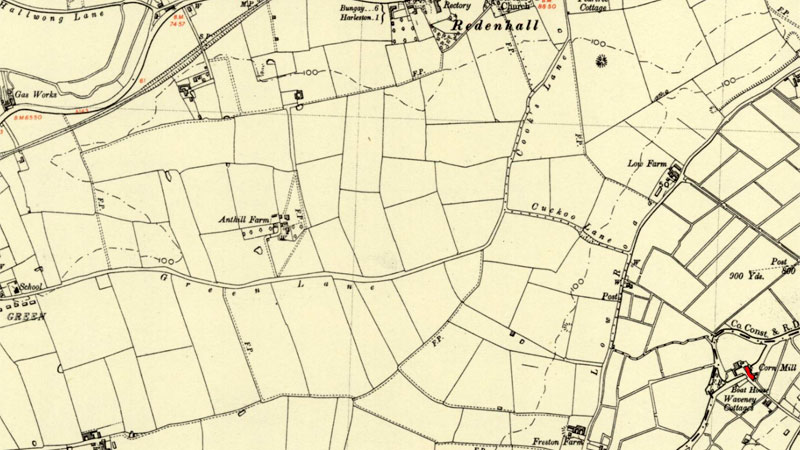 |
O. S. Map 1946 |
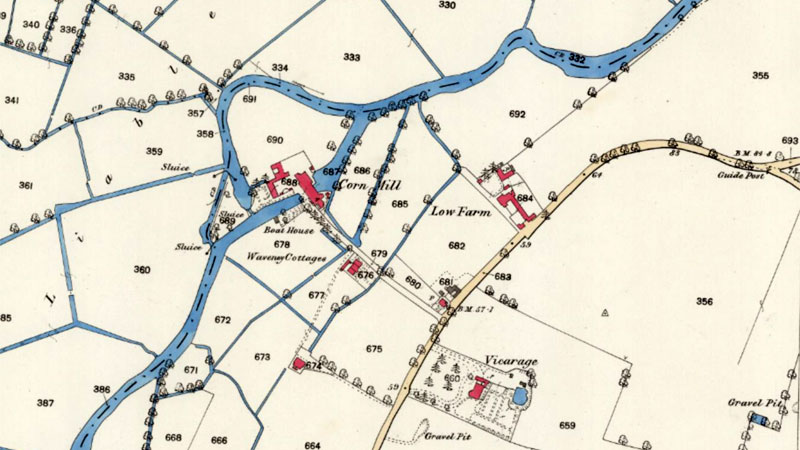 |
O. S. Map 1884 |
|
1611: George Herring of Norwich renting Fryer's Mill from the Abbot of Sibton, Suffolk
1905: 3 sack/hour roller plant installed |
If you have any memories, anecdotes or photos please let us know and we may be able to use them to update the site. By all means telephone 07836 675369 or
|
| Nat Grid Ref TM 27108334 | Copyright © Jonathan Neville 2003 |